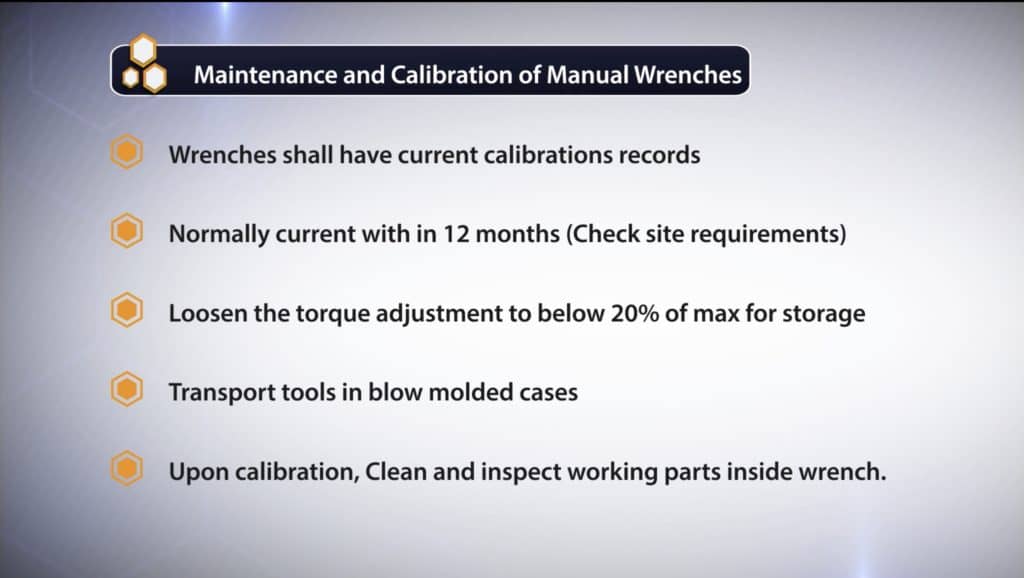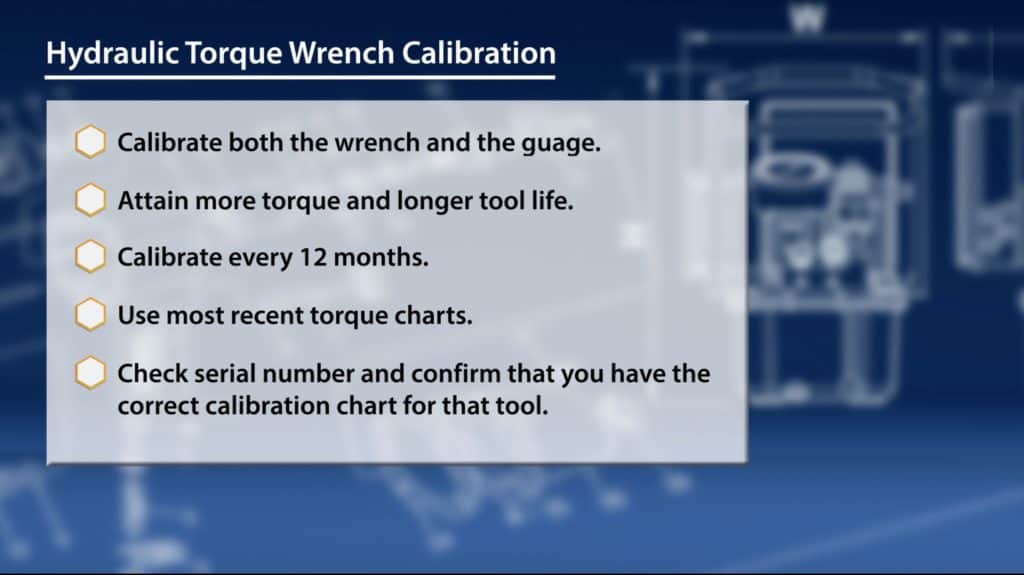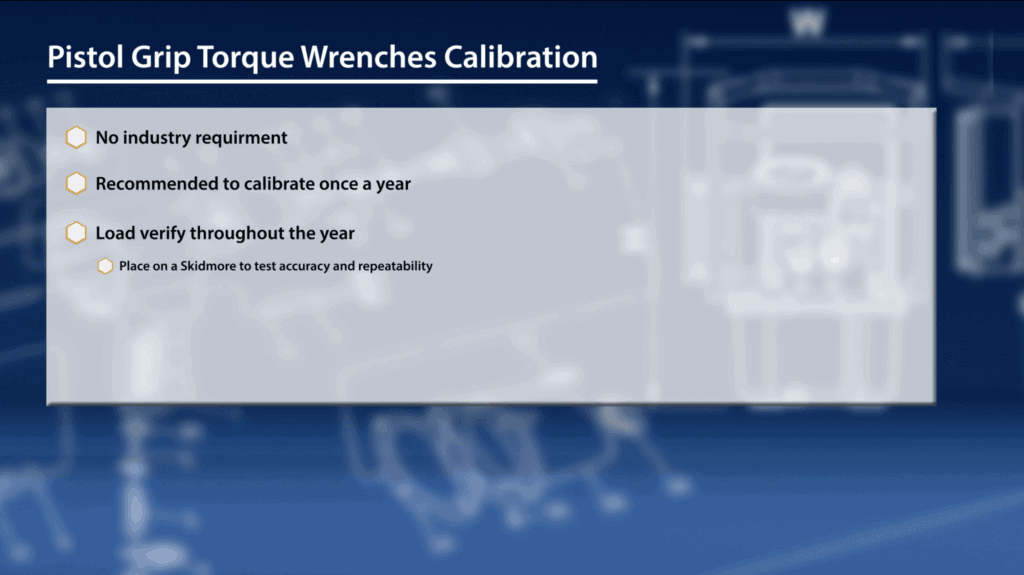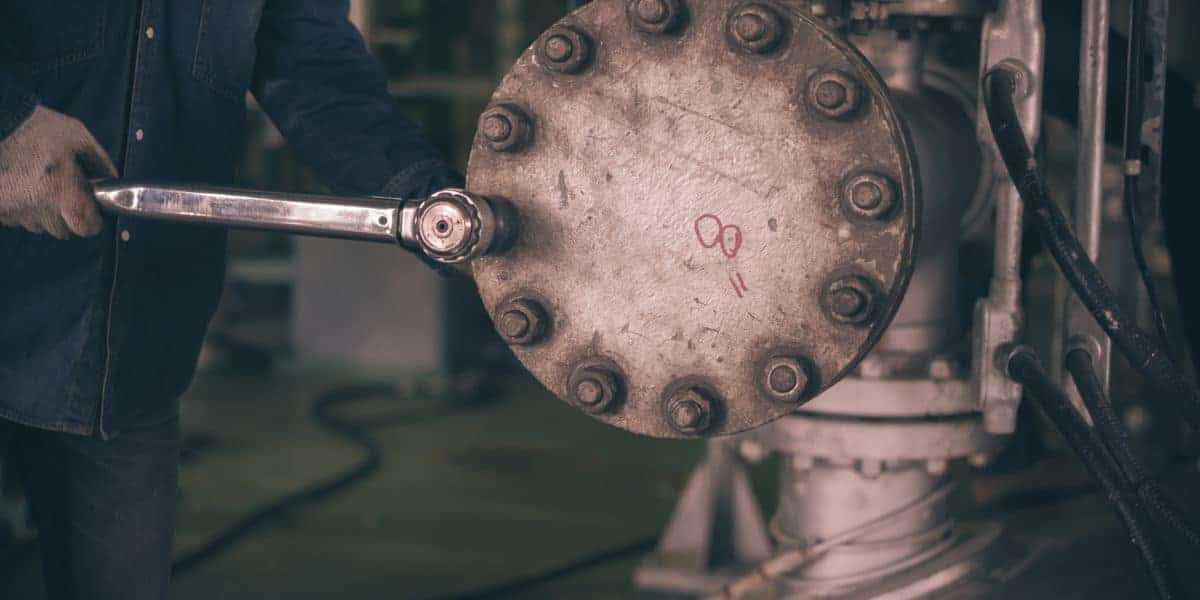Why Torque Calibration Matters
The torque wrench is the most-used product for achieving proper load on a fastener. Research shows all torque equipment — manual tools and power tools alike — requires calibration both upon purchase and periodically after use. They will not remain accurate infinitely throughout their lives.
Torque wrench calibration is a critical step in assembly, therefore, because even if you have a great process and skilled labor, your results won’t be good if you don’t have accurate tools.
In fact, the inaccuracies that can result from improperly set torque tools can be huge. We’ve seen in the field that, sometimes, wrenches will “click” at their target of 200 ft-lbs while being off by as much as 50 ft-lbs.
Usually these discrepancies are the result of damage during use. But that damage is often invisible, and therefore undetectable — unless you have some way of testing the tool’s calibration.
In this article, we’ll first review the essential practices of torque calibration. We’ll then discuss common torque tools used in industry, including manual torque wrenches and powered equipment (hydraulic, pneumatic, and battery torque wrenches). Then we will discuss methods for the field verification of these torque tools.
There are some new torque testers that are great for torque applications in the field. We will also discuss the frequency of torque wrench calibration and give you a brief explanation of how it works.
NOTE: The examples of equipment and manufacturers are from our experience only. There might be other options found in the industry.
Torque Tools Calibration: The Basics
All torque tools need to be calibrated by a calibration lab. However, since there is no standard for torque wrench calibration for Powered Equipment, and all torque wrenches experience uneven use, Hex Technology has done research on how to verify your torque wrenches repeatable accuracy while using field testing equipment.
It seems that anyone who performs torque calibration services would verify their calibration lab and methods, but Hex Technology has found that most manufacturers do not verify the calibration process of their employees and distributors. While these companies have NIST traceability on their torque transducers, they often don’t know how the tool actually stalls on the torque application.
It is not hard to do with either a micrometer on a standard fastener (measuring lbf vs. load), force gauges (like a Skidmore) with a fastener, or create their own torque sensor that has been verified. Some manufacturers have done this, but others are behind the curve.
Therefore, while we do not sell these products, Hex Technology recommends verifying your torque calibration service providers with the following methods.
Manual Torque Wrenches

Manual torque wrenches or “clicker wrenches” are the most common torque products in the marketplace, the most accurate type of torque wrenches, and have a standard to calibrate to (unlike powered equipment).
The manual torque wrench should not be used when you’re trying to achieve torque over 600 ft-lbs of torque. There are 1000 ft-lb and 2000 ft-lb clicker wrenches are available in the marketplace, but those are beasts for assemblers to use. So please use no greater than 600 ft-lbs.
The accuracy of clicker wrench torque products is between 3 and 5% depending upon the manufacturer. They shall be calibrated every six months per ISO 6789, “Assembly Tools For Screws And Nuts – Hand Torque Tools – Part 2: Requirements For Calibration And Determination Of Measurement Uncertainty.”
Dropping, hitting, or banging the wrench can change the output of the calibration. Also, if you don’t completely unwind it to less than 20% of the total scale after use, the load in the spring mechanism inside the torque wrench will get damaged and your torque wrench will need calibration yet again.
There are many different manufacturers of these wrenches but the ones that we have tested and have worked well are CDI (a Snap-on company), Mountz, and Proto.
Field Calibration for Manual Torque Wrenches (i.e. Clicker Wrenches)
We typically use the NORBAR torque testing equipment (we call them clicker checkers) at the beginning of shifts or use to ensure that the torque wrenches are within +/-5% within their stated torque target. If the wrench does not meet these criteria, you should send it in to your calibration lab for examination. When using these clicker checkers, note that the assembler can have a big effect on its accuracy, so a little training on how to properly use clickers should be a part of this process. We offer free online training for assemblers here.
Finally, for recalibration, ISO 6789 states that you shall calibrate these tools once a year, regardless of how much (or how little) you may have used them.
Powered Equipment
Electronic torque wrench
The Electronic torque wrench is fairly new to the marketplace. While more expensive than manual torque wrenches, electronic torque wrenches feature a digital display with buttons, so that the predetermined torque value is effortless.
These torque wrenches usually feature ratcheting square drives and many times also include a flexible head. The wrench can make a variety of different indications when the desired torque is met. It can beep and turn colors to alert you. The only thing missing is the old man on your crew sitting behind you saying, “Stop, stupid.”
These wrenches have been seen to be more fragile than typical manual torque wrenches. They are also susceptible to the same damage mechanisms (dropping, etc.).
Hydraulic Torque Wrench (low profile and square drive)

The hydraulic torque wrench has been around for a long time and was commercialized by Hytorc in 1968. Since then many other manufacturers have emerged, including Torsion X, BoltTech Mannings, and Enerpac.
These torque wrenches can do up to 180,000 ft-lbs and all the way down to 50 ft-lbs. They come in two styles: low-profile and square drive. Most manufacturers claim to have a +/-3% accuracy (of the full scale of the wrench) with 2% repeatability.
When repair services are completed on hydraulics they shall be recalibrated, according to standard, as it will affect accuracy.
Pneumatic Torque Wrench
The pneumatic torque wrench was commercialized by New World Technologies (RAD Torque Tools) 25 years ago and these are gear boxed torque multipliers. These were a step up in speed and ease of use since they weren’t attached to a hydraulic torque wrench pump.
Now there are other manufacturers — Hytorc, Mountz, NORBAR, and many more.
These torque wrenches can produce up to 15,000 ft-lbs and can also go to 50 ft-lbs. They are all square drive tools and claim to have a +/-5% accuracy (of full scale of the wrench) with 2% repeatability.
These are always re-calibrated after repair but you should ensure that they are with your chosen calibration lab.
Battery-Powered Torque Wrench

Our first experience with these was in the early 2000s with RAD Torque Tools in their earlier form. Today, the major manufacturers in the pneumatic marketplace are also making these torque wrenches.
These torque wrenches are becoming far more common in torque application. They are easier to use than pneumatic torque wrenches because they don’t need a basket and air hose to run the motor. Because their use is becoming more widespread, it is critical that the industry understands them better.
These torque wrenches are very sensitive to how stiff the torque application is. Meaning, they perform differently on gasketed torque applications than they do on structural steel torque applications.
They can produce up to 10,000 ft-lbs, but also go down as low as 100 ft-lbs. They are also square drive tools that claim to have +/-5% accuracy (of the full scale of the wrench) with 2% repeatability.
These torque products need to be calibrated after every repair. Thankfully, it’s easy for calibration labs to adjust them.
Calibration for Powered Equipment
Strange but true: There is NO calibration standard in the marketplace for Powered Equipment. Therefore, just because a calibration lab states that they are ISO/IEC 17025 Accredited, it does not mean they know how to calibrate tools correctly. They just follow their procedure. It’s very much like ISO 9000 accreditation. Their torque transducers can simulate either the stiffness of a structural steel joint or a gasketed joint (which is softer). But which are they using?
So we have found that if you want to test a wrench in a lab or shop you can use NORBAR torque sensors which will allow you to verify that your wrench is within +/-10% accurate. This accuracy is acceptable for torque wrench verification.
If you would like to test your tool on an actual torque application, we have used the RAD Smart Socket. This will fit on any size square drive and they make it for different size nuts.
To use the Smart Socket, you just insert your square drive into the socket, turn it on and apply your torque. It will read the torque value and as long as you are +/-10% accurate, you can consider that a win for torque verification.
RELATED:
K-Factor: How to Use and Understand This Essential Calculation
PTFE Coated Studs: Do They Work?
Join Industry Leaders!
Subscribe to Hex Technology today and we’ll give you $700 in bolting courses, FREE. Your path to a safer, more reliable, more profitable site starts here.


